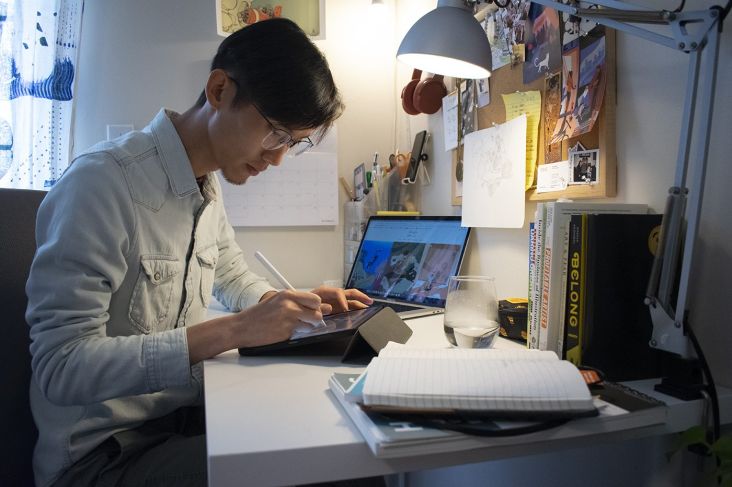Don't get left behind in your career: add motion design to your skills today
There was a time when motion design was a niche skill, something that was needed only occasionally. And when that happened, there were a small number of specialised practitioners and agencies clients could turn to.

Image licensed via Shutterstock / Photographee.eu
In 2019, however, that’s all changed, and the landscape is entirely different.
The rise of digital over recent years means motion design has become more and more important across the creative industries. And that trend is only accelerating as devices, and networks get faster. Emerging projects such as Space X’s new satellite network bring high-speed internet to the “next billion” in the developing world.
Elsewhere, the rise of digital billboards, which are now ubiquitous in major city centres and on London’s Underground, is also boosting the demand for designers skilled in motion design. After all, who wants to advertise with a dull, static image, when you can attract far more customers with a dynamic, animated one? The same principle applies to the digital ordering screens now springing up in fast-food restaurants like McDonald's.
And what about streaming TV? As new services from the likes of Disney and Apple gear up to take on Netflix and Amazon in the war for eyeballs, more and more new, high-quality video content is inevitably going to be commissioned. And again, motion design is going to be a big part of that coming explosion in creative activity.
Why you should learn motion design
In short, few areas of design and media don’t have a motion design element. Motion design is being used in TV commercials and YouTube videos, explainer videos and tutorials, logo animations and social media videos, educational content and corporate promos… the list, frankly, is endless.
So if you’re working as a graphic designer, isn’t it about time you got on board with motion design?
Getting trained in motion design, right now, seems like a career no-brainer. It’s a valuable extra string to your bow which could help you get that promotion, new job or freelance opportunity you’ve been craving.
In broader terms, it’s a skill that more and more of us are inevitably going to need as graphic designers in the future. And if we get ahead of the curve now, it’s only going to be beneficial later on.
After all, consider the environment we might find ourselves in five or ten years from now. Remember, the design sector in the UK has expanded massively throughout the 2010s, and it’s now the largest in Europe. But going forward, all those hundreds of thousands of extra designers represent your competition. And if that industry begins to contract for any reason in the 2020s (cough Brexit cough), you need to be in an excellent position to protect your position against rivals.
New opportunities
Plus of course, if you start to enjoy motion design, there’s no reason you can make a sideways move from graphic designer to fully specialised motion designer.
Doing so, right now, would open up a whole new world of creative jobs. At the time of writing, for instance, The Guardian has 23 motion design jobs listed in the UK, with salaries ranging from £22K for a graduate position at a new startup, right up to £65K for a senior position at a TV network. Vacancies are available everywhere, from advertising, marketing and design agencies, web design and development studios, and animation, videogame, TV and movie studios.
Future-proofing your career, improving your prospects and expanding your creative opportunities: whether you’re a new graduate or an established illustrator or graphic designer looking to expand on your skill set, these are all great reasons to start learning motion design.
But how, exactly, do you go about it?
How to learn motion design
There’s no reason you can’t learn the basics of motion design from video walkthroughs you can find on tutorial websites, YouTube or Vimeo. But do you want to?
Yes, it’s nice to find free resources online, but you know in your heart of hearts that it’s not the best way to learn a new discipline. It’s all going to be very bitty, there will be big gaps in your knowledge, and there’ll be no one to look over your shoulder and ask for help when you get into difficulties.
That’s why Created offers a nine-month, part-time course that will teach you the skills you need to become a motion designer, in a flexible way that you can combine with your job or education.
Whether your background is in graphic design or animation, this course will give you the training you need to master the art of motion design. You’ll learn all the fundamentals of motion (using Adobe After Effects and Cinema 4D software), but there’s also a strong practical focus on the course too.
Created believes that learning is about doing, and so it has partnered with leading companies in the field to provide you with practical skills and knowledge you need to be industry-ready.
Throughout the course, you’ll tackle real-world briefs under the guidance of your mentor, including a series of one-to-one coaching sessions. The curriculum is closely aligned with what employers in today’s creative world need from motion designers, so you’ll be in a great position to be the perfect fit for any job you apply for.
Another advantage of this course over sitting at home and trying to work things out for yourself is that you’ll be in good company, learning alongside other ambitious creatives through a combination of online learning content and physical sessions. This will give you an excellent grounding from which to grow your network.
By the end, you’ll have six professional-level projects for your portfolio. And you’ll be able to do all of this in a flexible way that suits your lifestyle.
To learn more about how to become a motion designer, visit Created today.























](https://www.creativeboom.com/upload/articles/af/af4d07206f762fa288220c1f480fc6345e83bc8a_732.jpg)


